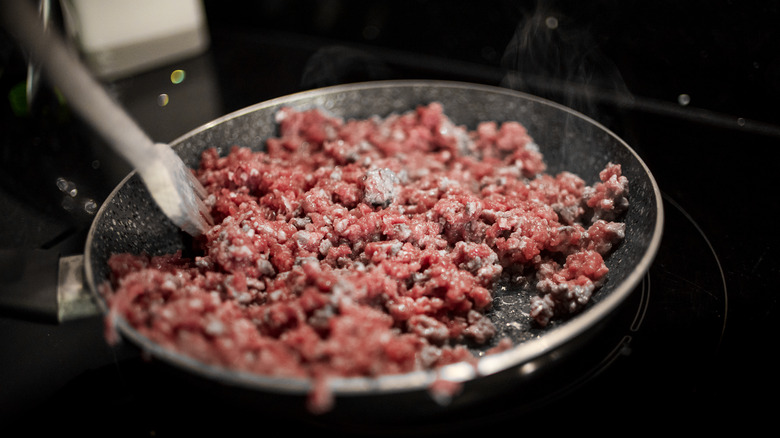The Practical Way To Use Your Grease From Cooked Ground Beef
A little grease in ground beef is tasty, but too much can make your dish an oily mess. Just like throwing away bacon grease is a mistake, so too is binning beef grease without a second thought. One of the biggest reasons to keep it around is that beef grease is an exceptional catch-all for flavor. This is because the flavorful compounds found in spices and herbs break down and become concentrated in fat. The result is a ridiculously tasty grease that can be used to impart different aromas to a variety of dishes. For example, say you're cooking spaghetti with a ground beef sauce. Once you drain the grease, some of it can be mixed with garlic and herbs and cooked in a pot. After the herbs become fragrant, this aromatic grease can be added to your sauce for an extra punch of flavor.
Similarly, ground beef grease can be used to add nuance to soups, gravies, roux, or sautéed vegetables. Its high smoke point also makes it a good choice for frying things like eggs, hash browns, and even French fries. In fact, McDonald's used beef tallow for its fries until the 1990s. For reference, beef tallow is rendered beef fat, specifically made from dense fat found on a cow's kidneys. While the fat from ground beef isn't exactly the same (tallow comes from subcutaneous fat with high triglycerides and ground beef fat is intramuscular), they can be used in similar ways for flavoring.
Storing grease from ground beef to use later
Like bacon grease, you can save the grease from your ground beef to flavor dishes later. However, it's not as simple as draining the grease into a mason jar and sticking it in the fridge to solidify. For one, you should strain beef grease the same way you'd strain bacon grease to remove any remaining pieces of meat. Moreover, ground beef has a lot of naturally occurring water in it, which will later cause the fat and water to separate during cooling. This happens because the triglycerides in the fat are less dense, meaning it can float on top of water.
This separation can be used to your advantage. After pouring your grease into an airtight jar or container, flip it upside down and store it in your fridge. The reason for flipping it over is that the fat will gather at the top of the jar (the bottom in this case), while the water gathers beneath it. Once things are separated, you can open the jar and quickly drain the water, leaving only the collected fat.
Beef grease that's strained and stored correctly can last for months, especially when refrigerated. Like bacon grease, it can also be frozen and kept almost indefinitely. That said, if your grease begins smelling rancid or sour and takes on a yellowish hue, it's time to toss it and start again.

